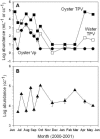A persistent, productive, and seasonally dynamic vibriophage population within Pacific oysters (Crassostrea gigas)
- PMID: 16151121
- PMCID: PMC1214601
- DOI: 10.1128/AEM.71.9.5324-5331.2005
A persistent, productive, and seasonally dynamic vibriophage population within Pacific oysters (Crassostrea gigas)
Abstract
In an effort to understand the relationship between Vibrio and vibriophage populations, abundances of Vibrio spp. and viruses infecting Vibrio parahaemolyticus (VpVs) were monitored for a year in Pacific oysters and water collected from Ladysmith Harbor, British Columbia, Canada. Bacterial abundances were highly seasonal, whereas high titers of VpVs (0.5 x 10(4) to 11 x 10(4) viruses cm(-3)) occurred year round in oysters, even when V. parahaemolyticus was undetectable (< 3 cells cm(-3)). Viruses were not detected (<10 ml(-1)) in the water column. Host-range studies demonstrated that 13 VpV strains could infect 62% of the V. parahaemolyticus strains from oysters (91 pairings) and 74% of the strains from sediments (65 pairings) but only 30% of the water-column strains (91 pairings). Ten viruses also infected more than one species among V. alginolyticus, V. natriegens, and V. vulnificus. As winter approached and potential hosts disappeared, the proportion of host strains that the viruses could infect decreased by approximately 50% and, in the middle of winter, only 14% of the VpV community could be plated on summer host strains. Estimates of virus-induced mortality on V. parahaemolyticus indicated that other host species were required to sustain viral production during winter when the putative host species was undetectable. The present study shows that oysters are likely one of the major sources of viruses infecting V. parahaemolyticus in oysters and in the water column. Furthermore, seasonal shifts in patterns of host range provide strong evidence that the composition of the virus community changes during winter.
Figures




References
-
- Arias, C. R., M. C. Macian, R. Aznar, E. Garay, and M. J. Pujalte. 1999. Low incidence of Vibrio vulnificus among vibrio isolates from sea water and shellfish of the Western Mediterranean coast. J. Appl. Microbiol. 86:125-134. - PubMed
-
- Baross, J. A., J. Liston, and R. Y. Morita. 1974. Some implications of genetic exchange among marine vibrios, including Vibrio parahaemolyticus, naturally occurring in the Pacific Oyster, p. 129-137. In T. Fujino, G. Sakaguchi, R. Sakazaki, and Y. Takeda (ed.), International Symposium on Vibrio parahaemolyticus: Proceedings of the Second U.S.-Japan Conference on Toxic Micro-Organisms. United States-Japan Cooperative Program on Development and Utilization of Natural Resources, Tokyo, Japan.
-
- Børsheim, K. Y. 1993. Native marine bacteriophages. FEMS Microbiol. Ecol. 102:141-159.
-
- Cavallo, R. A., and L. Stabili. 2004. Culturable vibrios biodiversity in the Northern Ionian Sea (Italian coasts). Sci. Mar. 68:23-29.
Publication types
MeSH terms
LinkOut - more resources
Full Text Sources
Molecular Biology Databases
Research Materials
Miscellaneous

